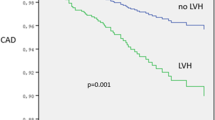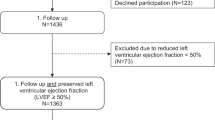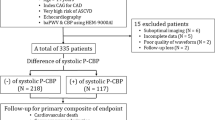Abstract
Pulse wave velocity (PWV), the carotid augmentation index (AIx), and pulse pressure (PP) may be prognostic factors in heart failure, but the possible influence of the ejection fraction (EF) and other simple haemodynamic variables on them has not been investigated in this setting. Noninvasive methods were used to measure carotid-radial (CR), carotid-femoral (CF) PWV and AIx, and brachial PP, in 135 consecutive patients with stable symptomatic chronic heart failure. The patients were divided into two groups, with preserved (⩾40%) or reduced (<40%) EF. CF-PWV, AIx and PP were lower in the decreased EF group (8.85±2.77 versus 10.60±2.75 m/s, P<0.001; 121±21 versus 132±24, P=0.009 and 41±19 versus 67±17 mmHg, P<0.001), but CR-PWV values were similar regardless of the EF status. These results were not modified after adjustment for age and sex. Multiple regression analysis showed that AIx and PP were systematically related to time domain parameters (heart rate or ejection duration) and EF, whatever the group. CF-PWV was weakly related to time domain values and unrelated to mean blood pressure (BP) or EF in the preserved EF group, whereas it was related to both mean BP and EF in the low EF group. In conclusion, whatever the EF level, PP and AIx were strongly modulated in the time domain, by pressure and by the EF level. The same relationships were found with CF-PWV, but only in the reduced EF group. Whether CF-PWV is the best prognostic factor in patients with ‘diastolic’ heart failure must be confirmed in a prospective study.
This is a preview of subscription content, access via your institution
Access options
Subscribe to this journal
Receive 12 digital issues and online access to articles
$119.00 per year
only $9.92 per issue
Buy this article
- Purchase on Springer Link
- Instant access to full article PDF
Prices may be subject to local taxes which are calculated during checkout
Similar content being viewed by others
References
Darne B, Girerd X, Safar M, Cambien F, Guize L . Pulsatile versus steady component of blood pressure: a cross-sectional analysis and a prospective analysis on cardiovascular mortality. Hypertension 1989; 13: 392–400.
Madhavan S, Ooi WL, Cohen H, Alderman MH . Relation of pulse pressure and blood pressure reduction to the incidence of myocardial infarction. Hypertension 1994; 23: 395–401.
Kannel WB, Wolf PA, McGee DL, Dawber TR, McNamara P, Castelli WP . Systolic blood pressure, arterial rigidity, and risk of stroke: the Framingham study. JAMA 1981; 245: 1225–1229.
Haider AW, Larson MG, Stanley SF, Levy D . Systolic blood pressure, diastolic blood pressure, and pulse pressure as predictors of risk for congestive heart failure in the Framingham Heart Study. Ann Intern Med 2003; 138: 10–16.
Chae CU, Pfeffer MA, Glynn RJ, Mitchell GF, Taylor JO, Hennekens CH . Increased pulse pressure and risk of heart failure in the elderly. JAMA 1999; 281: 634–639.
Mitchell GF, Moyé LA, Braunwald E, Rouleau JL, Bernstein V, Geltman EM et al. for the SAVE Investigators. Sphygmomanometrically determined pulse pressure is a powerful independent predictor of recurrent events after myocardial infarction in patients with impaired left ventricular function. Circulation 1997; 96: 4254–4260.
Domanski MJ, Mitchell GF, Norman J, Exener D, Pitt B, Pfeffer MA . Independent prognostic information provided by sphygmomanometrically determined pulse pressure and mean arterial pressure in patients with left ventricular dysfunction. J Am Coll Cardiol 1999; 33: 951–958.
Aronson D, Burger AJ . Relation between pulse pressure and survival in patients with decompensated heart failure. Am J Cardiol 2004; 93: 785–788.
Voors AA, Petrie CJ, Petrie MC, Charlesworth A, Hillege HL, Zijlstra F et al. Low pulse pressure is independently related to elevated natriuretic peptides and increased mortality in advanced chronic heart failure. Eur Heart J 2005. Apr 15; [Epub ahead of print].
Laurent S, Boutouyrie P, Asmar R, Gautier I, Laloux B, Guize L et al. Aortic stiffness is an independent predictor of all cause and cardiovascular mortality in hypertensive patients. Hypertension 2001; 37: 1236–1241.
Meaume S, Benetos A, Henry OF, Rudnichi A, Safar ME . Aortic pulse wave velocity predicts cardiovascular mortality in subjects >70 years of age. Arterioscler Thromb Vasc Biol 2001; 21: 2046–2050.
Cruickshank K, Riste L, Anderson SG, Wright JS, Dunn G, Gosling RG . Aortic pulse-wave velocity and its relationship to mortality in diabetes and glucose intolerance. An integrated index of vascular function? Circulation 2002; 106: 2085–2090.
Nurnberger J, Keflioglu-Scheiber A, Opazo Saez AM, Wenzel RR, Philipp T, Schafers RF . Augmentation index is associated with cardiovascular risk. J Hypertens 2002; 20: 2407–2414.
London GM, Blacher J, Pannier B, Guerin AP, Marchais SJ, Safar ME . Arterial wave reflections and survival in end-stage renal failure. Hypertension 2001; 38: 434–438.
Westerhof N, O'Rourke MF . Hemodynamic basis for the development of left ventricular failure in systolic hypertension and for its logical therapy. J Hypertens 1995; 13: 943–952.
Lantelme P, Mestre C, Lievre M, Gressard A, Milon H . Heart rate: an important confounder of pulse wave velocity assessment. Hypertension 2002; 39: 1083–1087.
Nurnberger J, Saez AO, Dammer S, Mitchell A, Wenzel RR, Philipp T et al. Left ventricular ejection time: a potential determinant of pulse wave velocity in young, healthy males. J Hypertens 2003; 21: 2125–2132.
Giannattasio C, Vincenti A, Failla M, Capra A, Cirò A, De Ceglia S et al. Effects of heart rate changes on arterial distensibility in humans. Hypertension 2003; 42: 253–256.
Wilkinson IB, Mohammad NH, Tyrrell S, Hall IR, Webb DJ, Paul VE et al. Heart rate dependency of pulse pressure amplification and arterial stiffness. Am J Hypertens 2002; 15: 24–30.
O'Rourke MF, Hayward CS . Arterial stiffness, gender and heart rate. J Hypertens 2003; 21: 487–490.
Mitchell GF, Parise H, Benjamin EJ, Larson MG, Keyes MJ, Vita JA et al. Changes in arterial stiffness and wave reflection with advancing age in healthy men and women the Framingham Heart Study. Hypertension 2004; 43: 1239–1245.
Logeart D, Saudubray C, Beyne P, Thabut G, Ennezat PV, Chavelas C et al. Comparative value of Doppler echocardiography and B-type natriuretic peptide assay in the etiologic diagnosis of acute dyspnea. J Am Coll Cardiol 2002; 40: 1794–1800.
Logeart D, Thabut G, Jourdain P, Chavelas C, Beyne P, Beauvais F et al. Predischarge B-type natriuretic peptide assay for identifying patients at high risk of re-admission after decompensated heart failure. J Am Coll Cardiol 2004; 43: 635–641.
Wilkinson IB, Fuchs SA, Jansen IM, Spratt JC, Murray GD, Cockcroft JR et al. The reproducibility of pulse wave velocity and augmentation index measured by pulse wave analysis. J Hypertens 1998; 16: 2079–2084.
Touche T, Prasquier R, Merillon JP, Barthelemy M, Hanoun HC, Vervin P et al. Mesure des volumes ventriculaires gauches par echocardiographie bidimensionnelle à partir d'une coupe apicale. Arch Mal Cœur 1980; 73: 691–700.
Teichholz LE, Kreulent T, Herman MV, Gorlin R . Problems in echocardiographic volume determinations: echocardiographic-angiographic correlation in the presence or absence of asynergy. Am J Cardiol 1976; 37: 7–11.
Hintze JL . Number Cruncher Statistical System. User manual. Statistical solutions limited: Ireland, 1995.
Kawaguchi M, Hay I, Fetics B, Kass DA . Combined ventricular systolic and arterial stiffening in patients with heart failure and preserved ejection fraction. Implications for systolic and diastolic reserve limitations. Circulation 2003; 107: 714–720.
Mitchell GF, Tardiff JC, Arnold JMO, Marchiori G, O'Brien TX, Dunlap ME et al. Pulsatile hemodynamics in congestive heart failure. Hypertension 2001; 38: 1433–1439.
Pepine CJ, Nichols WW, Conti R . Aortic input impedance in heart failure. Circulation 1978; 58: 460–465.
Mérillon JP, Fontenier G, Lerallut JF, Jaffrin MY, Chastre J, Assayag P et al. Aortic input impedance in heart failure: comparison with normal subjects and its changes during vasodilator therapy. Eur Heart J 1983; 4(Suppl G): 13–20.
Kromer EP, Elsner D, Holmer SR, Müntze A, Riegger GAJ . Aortic input impedance and neurohormonal activation in patients with mild to moderate chronic congestive heart failure. Cardiovasc Res 1992; 26: 265–272.
Arnold JMO, Marchiori GE, Imrie JR, Burton GL, Pflugfelder PW, Kostuk WJ . Large artery function in patients with chronic heart failure. Studies of brachial artery diameter and hemodynamic. Circulation 1991; 84: 2418–2425.
Giannattasio C, Failla M, Stella ML, Mangoni AA, Carugo S, Pozzi M et al. Alterations of radial artery compliance in patients with congestive heart failure. Am J Cardiol 1995; 76: 381–385.
Khder Y, El Ghawi R, Bray des Boscs L, Aliot E, Zannad F . Investigations of the peripheral vascular mechanisms implicated in congestive heart failure by the non invasive evaluation of radial artery compliance and reactivity. Int J Cardiol 1996; 56: 149–158.
Kelly RP, Millasseau SC, Ritter JM, Chowienczyk PJ . Vasoactive drugs influence aortic augmentation index independently of pulse-wave velocity in healthy men. Hypertension 2001; 37: 1429–1433.
Cohen-Solal A, Aupetit JF, Gueret P, Kayanakis J, Zannad F . Abnormalities of the peripheral circulation and tolerance to exertion of patients with heart failure. Arch Mal Coeur Vaiss 1989; 37: 1429–1433.
Hillege HL, Girbes AR, de Kam PJ, Boomsma F, de Zeeuw D, Charlesworth A et al. Renal function, neurohormonal activation, and survival in patients with chronic heart failure. Circulation 2000; 102: 203–210.
Kass DA, Shapiro EP, Kawaguchi M, Capriotti AR, Scuteri A, de Groof RC et al. Improved arterial compliance by a novel advanced glycation end-product crosslink breaker. Circulation 2001; 104: 1464–1470.
Susic D, Varagic J, Ahn J, Frohlich ED . Cardiovascular and renal effects of a collagen cross-link breaker (ALT 711) in adult and aged spontaneously hypertensive rats. Am J Hypertens 2004; 17: 328–333.
Liu J, Masurekar MR, Vatner DE, Jyothirmayi GN, Regan TJ, Vatner SF et al. Glycation end-product cross-link breaker reduces collagen and improves cardiac function in aging diabetic heart. Am J Physiol Heart Circ Physiol 2003; 285: H2587–H2591.
Acknowledgements
This work was in part realized with a grant from the French Federation of Cardiology.
Author information
Authors and Affiliations
Corresponding author
Additional information
Conflicts of interest
None.
Rights and permissions
About this article
Cite this article
Tartière, JM., Logeart, D., Safar, M. et al. Interaction between pulse wave velocity, augmentation index, pulse pressure and left ventricular function in chronic heart failure. J Hum Hypertens 20, 213–219 (2006). https://doi.org/10.1038/sj.jhh.1001965
Received:
Revised:
Accepted:
Published:
Issue Date:
DOI: https://doi.org/10.1038/sj.jhh.1001965
Keywords
This article is cited by
-
Examining arterial pulsation to identify and risk-stratify heart failure subjects with deep neural network
Physical and Engineering Sciences in Medicine (2024)
-
Children with inflammatory bowel disease already have an altered arterial pulse wave
European Journal of Pediatrics (2023)
-
Association of arterial stiffness and heart failure with preserved ejection fraction in the elderly population – results from the CARLA study
Journal of Human Hypertension (2022)
-
Inadequacy of Augmentation Index for Monitoring Arterial Stiffness: Comparison with Arterial Compliance and Other Hemodynamic Variables
Cardiovascular Engineering and Technology (2022)
-
Pulse sharpness as a quantitative index of vascular aging
Scientific Reports (2021)



